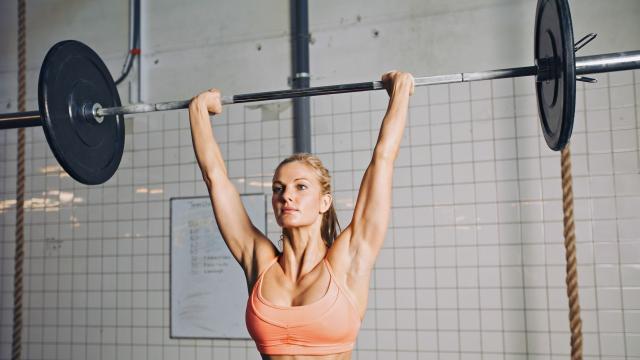It’s been a while since we did a fitness challenge focused on a specific lift, but now it is time. This November we’re going to get really familiar with the overhead press, the lift where you press a barbell to arms’ length above you while standing. It’s satisfying when you do it right but tricky in a few ways, so let’s tackle it together.
What do I need?
For barbell overhead press — often just called OHP or just “press” — you’ll need a barbell. If you don’t have one, you can still do this lift with a dumbbell or a kettlebell in each hand, or in one hand at a time.
You’ll want your feet to be stable, so kick off those running shoes. I usually do press in Chucks, because they’re flat and sturdy, or in my squat shoes, which are also fine. Some people prefer to be barefoot; that’s fine too (gym rules permitting).
When the weight gets heavy, you may benefit from a belt and a pair of wrist wraps, but those are a personal preference. I say if you use wrist wraps when you bench, use them here. If you have no idea what I’m talking about, you’re fine. Don’t worry about it.
How to press
If you’re learning the overhead press for the first time, you’re better off finding an in-person coach or watching videos than reading my description of it. So I’d recommend something like this video from Alan Thrall that walks you through how to set up, what constitutes proper form, and how to fix common mistakes.
But, in brief: You either pick up the barbell from the rack or you “clean” it off the floor. You hold it at chest level, with your forearms vertical underneath it, supporting it like pillars. And then you straighten your arms to press it overhead.
In a strict press, your legs are straight the whole time. In a push press, you bend your knees at the start, giving the bar some oomph to get it moving. Because of this extra help, you’ll be able to push press more than you can strict press. Don’t let these two moves blur together! If you’re strict pressing, keep your knees straight. If you’re push pressing, push with purpose.
Why it’s tricky
There are two things about this lift that make it tricky for beginners keep experienced lifters on their toes.
First, your head is in the way. At the start, the bar is in front of your shoulders; by the end, it’s directly over your shoulders. That means the bar needs to take a diagonal path passing through roughly the area of your forehead.
It’s not efficient to move the bar around your head; you need to move your head out of the way of the bar. And the way to do this is really to lean your entire torso back a bit, keeping tension in it the whole time. If your abs and butt are sore after a day of heavy presses, you’re probably doing something right.
The other problem is just that press is a weak lift, compared to your squat, bench, and deadlift. It just uses smaller muscles. This means you shouldn’t expect huge numbers at first, and your progress over time may seem maddeningly slow.
Stick with it, though. You may need more volume (more total sets per week) to progress on OHP than on other lifts. It may also be handy to use tiny weight plates to add a few pounds at a time as you get stronger. By the same token, if you can’t lift a full-size barbell when you start working on this lift, start with dumbbells and work your way up.
Whether you’re new to OHP or choosing to put some extra focus on it this month, give this lift a try and let us know in the comments how it goes for you. (I’m doing axle presses, cleaned from the ground for every set, and following the sets and reps of this notorious, allegedly Russian squat program. I am perhaps a bit of an overachiever, and this is one of my favourite lifts. You do you.)

Leave a Reply
You must be logged in to post a comment.